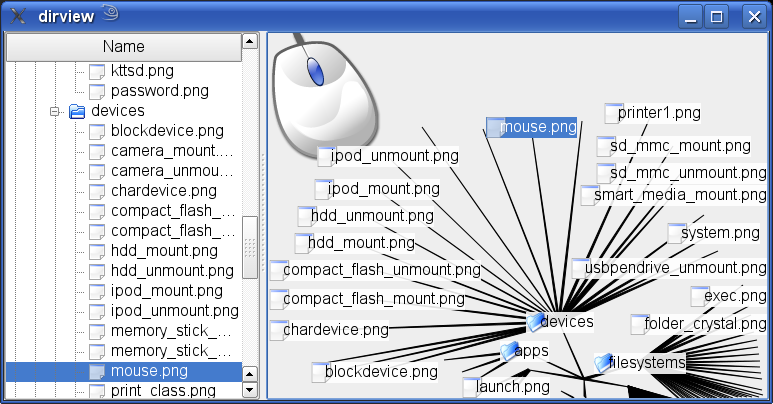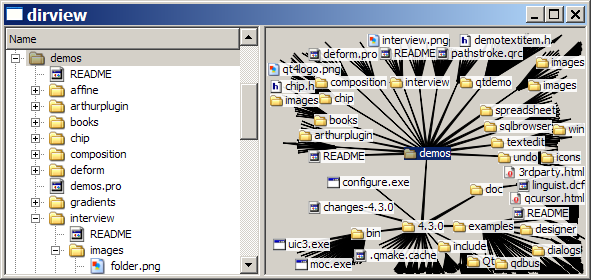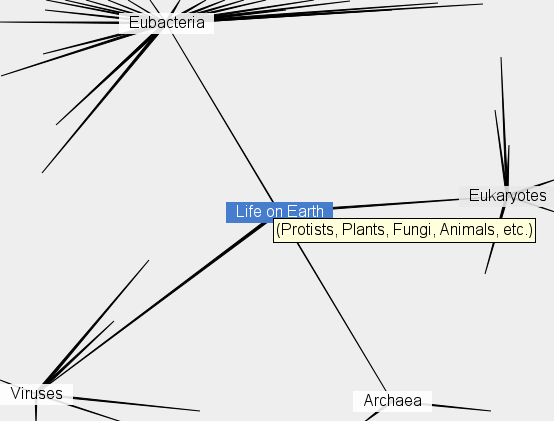WarpTree
WarpTree provides a widget, WarpTreeView, that can display any
hierarchical data set.
Download version 1.0.0 source
code
- Authors:
- Jos van den Oever
License: LGPL
The amount of data people are handling day to day is steadily
increasing. Getting an overview of a large data sets can be a
daunting task. For visualizing near-infinite data sets, one would
need a near-infinite screen size. Or a convenient way of mapping
the infinite screensize to a finite area. Such a methods exist. A
popular method is to lay the data out in a hyperbolic plane and
visualizing this on a Poincaré disk. Such a disk has a
high resolution view of the plane in thecenter and a low resolution
on the edges. The Poincaré disk was nice visualized by
the Dutch graphic artist M.C. Escher.

Circle Limit I by MC Escher
Because we are not artist and do not want to waste space, we
came up with a different projection which we simply call 'warped'.
It is the same as the projection above, but points are extended
from the center of the projection to the edge of the containing
rectangle. If we apply this method to 'Circle Limit I' we get this
image:

Square Limit I generated with warp
So what type of view is WarpTreeView? It is a bit like a
QTreeView, but
for larger data sets. The best way to understand it is to use
it.

Showing the graph on a unit disc.

Showing the graph in WarpTreeView.
- dynamic loading of the network
- showing labels of nodes if there is room for them regardless of
position in the hierarchy
- no overlapping labels
- adaptable to different datatypes and styles by implementing a
WarpNodePainter
- zooming with the mousewheel to see different levels of
detail
- change the projection with cursor keys and <Home> or by
dragging the tree
- show tooltips if the model provides information for them
DirView is a simple application that uses a QDirModel to browse
your files. Looking at the code is very insightfull if you want to
start using WarpTreeView. Here you see a
screenshot of DirView. On the left you see a normal QTreeView and
on the right you see the WarpTreeView. The two views share the
same data model and the same selection model. This means that if
you select an item in one view, it is also selected in the other
view.
The way the background, the nodes and the lines are drawn can be
customized by subclassing WarpNodePainter. The default
WarpNodePainter
does not draw a background. In DirView, an adapted WarpNodePainter is used: if
the active file is a picture, ImageNodePainter draws the picture in
the background of the view. This allows the user to browse for
pictures while keeping an eye on the potentially large directory
structure.

The DirView example application showing an image
preview.

The DirView example application running under Windows
XP.
The program 'tol', that comes with this package, allows you to
view the tree. You can start it with 'tol'. This loads a phylogeny
with 88000 nodes. This is what you see:

Zoomed out view of the tree of life.

Far zoomed out view of the tree of life.

Zoomed in view of the tree of life with
tooltip.
The data from the tree of life can be used for non-commercial
use as is stated on the
download website.
You can use WarpTree by instanciating a WarpTreeView and adding your data to
it in the form of a QAbstractItemModel. Examples on how to do it
can be found in dirview/main.cpp and treeoflife/tol.cpp.
All you need to use the widget is the dynamic library and the
header 'warptreeview.h'.
WarpTree comes with a plugin that, when installed, shows up in Qt
Designer automatically. It appears in the widget sidebar and can be
dragged onto dialogs and applicion windows like any other widget.

Schema showing how the warped widget makes better use of
the available space by mapping from a circle to a
square.
Generated on Sun Jun 3
19:54:02 2007 for WarpTree by  1.5.0
1.5.0











 1.5.0
1.5.0